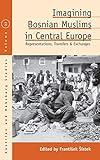Imagining Bosnian Muslims in Central Europe : Representations, Transfers and Exchanges / ed. by František Šístek.
Material type: TextSeries: Austrian and Habsburg Studies ; 32Publisher: New York ; Oxford : Berghahn Books, [2021]Copyright date: ©2021Description: 1 online resource (302 p.)Content type:
TextSeries: Austrian and Habsburg Studies ; 32Publisher: New York ; Oxford : Berghahn Books, [2021]Copyright date: ©2021Description: 1 online resource (302 p.)Content type: - 9781789207743
- 9781789207750
- 305.6/9708991839043 23/eng/20230216
- online - DeGruyter
| Item type | Current library | Call number | URL | Status | Notes | Barcode | |
|---|---|---|---|---|---|---|---|
 eBook
eBook
|
Biblioteca "Angelicum" Pont. Univ. S.Tommaso d'Aquino Nuvola online | online - DeGruyter (Browse shelf(Opens below)) | Online access | Not for loan (Accesso limitato) | Accesso per gli utenti autorizzati / Access for authorized users | (dgr)9781789207750 |
Frontmatter -- CONTENTS -- Acknowledgements -- Introduction -- Chapter 1. The ‘Turkish Threat’ and Early Modern Central Europe: Czech Reflections -- Chapter 2. The Muslims of Bosnia and Herzegovina between Millet and Nation -- Chapter 3. Ambivalent Perceptions: Austria–Hungary, Bosnian Muslims and the Occupation Campaign in Bosnia and Herzegovina (1878) -- Chapter 4. Sleeping Beauty’s Awakening: Habsburg Colonialism in Bosnia and Herzegovina, 1878–1918 -- Chapter 5. Th e Portrayal of Muslims in Austro-Hungarian State Primary School Textbooks for Bosnia and Herzegovina -- Chapter 6. Towards Secularity: Autonomy and Modernization of Bosnian Islamic Institutions under Austro-Hungarian Administration -- Chapter 7. Under the Slavic Crescent: Representations of Bosnian Muslims in Czech Literature, Travelogues and Memoirs, 1878–1918 -- Chapter 8. Divided Identities in the Bosnian Narratives of Vjenceslav Novak and Rebecca West -- Chapter 9. Austronostalgia and Bosnian Muslims in the Work of Croatian Anthropologist Vera Stein Erlich -- Chapter 10. Th e Serbian Proverb Poturica gori od Turčina (A Turk-Convert Is Worse Th an a Turk): Stigmatizer and Figure of Speech -- Chapter 11. From Brothers to Others? Changing Images of Bosnian Muslims in (Post-)Yugoslav Slovenia -- Chapter 12. Exploring Religious Views among Young People of Bosnian Muslim Origin in Berlin -- Chapter 13. The West, the Balkans and the In-Between: Bosnian Muslims Representing a European Islam -- Conclusion -- Index
restricted access online access with authorization star
http://purl.org/coar/access_right/c_16ec
As a Slavic-speaking religious and ethnic “Other” living just a stone’s throw from the symbolic heart of the continent, the Muslims of Bosnia and Herzegovina have long occupied a liminal space in the European imagination. To a significant degree, the wider representations and perceptions of this population can be traced to the reports of Central European—and especially Habsburg—diplomats, scholars, journalists, tourists, and other observers in the late nineteenth and early twentieth centuries. This volume assembles contributions from historians, anthropologists, political scientists, and literary scholars to examine the political, social, and discursive dimensions of Bosnian Muslims’ encounters with the West since the nineteenth century.
Mode of access: Internet via World Wide Web.
In English.
Description based on online resource; title from PDF title page (publisher's Web site, viewed 25. Jun 2024)


